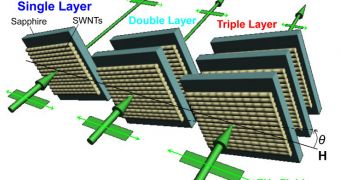A team of experts at the Rice University announces the development of a new class of terahertz polarizers, which make good use of carbon nanotubes for improving their performances. The devices could have applications in the fields of communication, sensing and security applications.
The robust terahertz polarizer the team developed was only made possible through the use of carbon nanotubes (CNT). The team behind the study says that the new polarizers could significantly advance fundamental studies of low-dimensional condensed matter systems.
In addition, it may be possible to use them to accelerate the development of new security and communication devices, in addition to non-invasive medical imaging systems and sensitive sensors.
What the instrument does is either block or allow terahertz radiations through, depending on its polarization. When opened, it lets 100 percent of all radiations pass through. When closed, it blocks up to 99.9 percent of the same radiation.
Details of how the polarizer functions were published in the latest online issue of the esteemed journal Nano Letters, which is edited by the American Chemical Society (ACS). The study was led by Rice professor of electrical and computer engineering, and of physics and astronomy, Junichiro Kono.
He explains that the device is able to either block or let pass waves from 0.5 to 2.2 terahertz, which means that it covers a much broader spectrum than existing polarizers. At this point, commercially-available terahertz polarizers are made up of fragile grids wrapped in gold or tungsten wires.
“We have pretty good terahertz emitters and detectors, but we need a way to manipulate light in this range. Our work is in this category, manipulating the polarization state – the direction of the electric field – of terahertz radiation,” Kono explains.
The reason why terahertz waves are so important is because they bridge the gap between infrared and microwave wavelengths, which gives them unique qualities. These include the ability to penetrate clouds, fabrics, solid objects and so on. However, they can pierce neither metal, nor water.
The new polarizer features three decks of aligned CNT on sapphire substrates. This thickness is not what the team was going for at first, but it's the only way to block terahertz radiation with a high degree of efficiency.
One of the challenges that remain in making this design commercially-available is developing a technique for obtaining specific types of carbon nanotubes. This issue is also plaguing a variety of other applications related to nanotechnology, but experts at Rice and elsewhere are hard at work towards fixing this problem.
The new study was funded by the US Department of Energy, the National Science Foundation and the Robert A. Welch Foundation.

 14 DAY TRIAL //
14 DAY TRIAL //